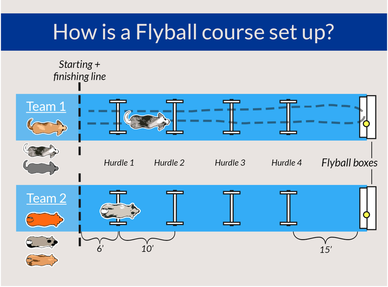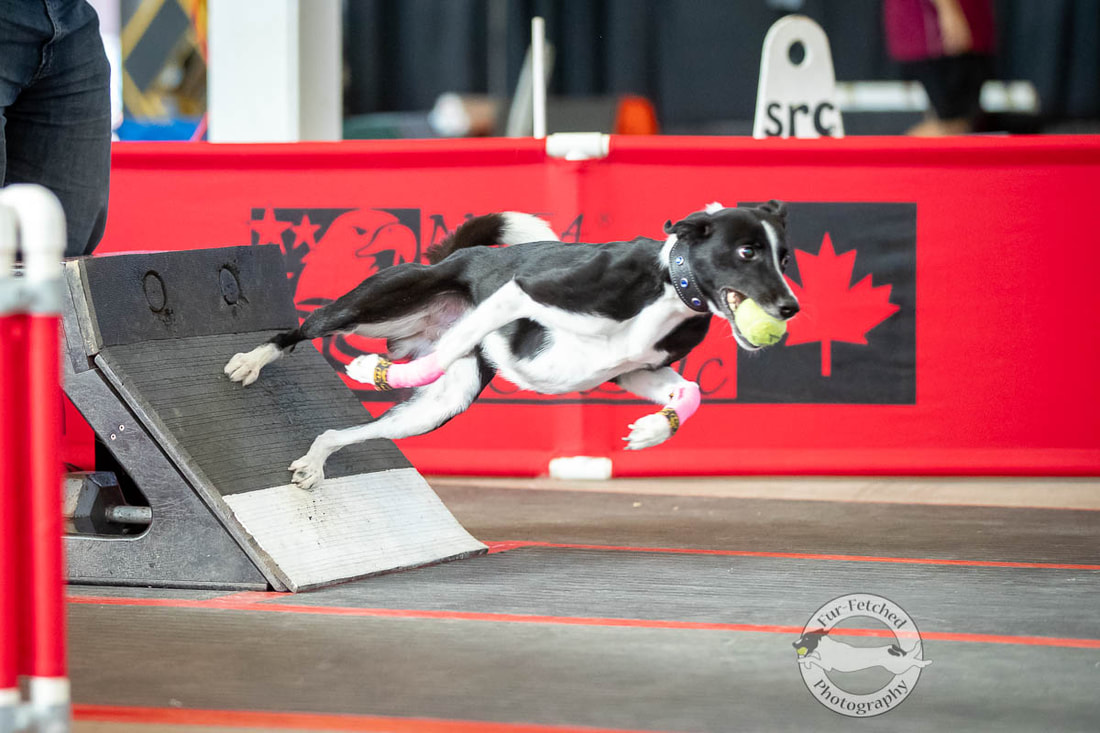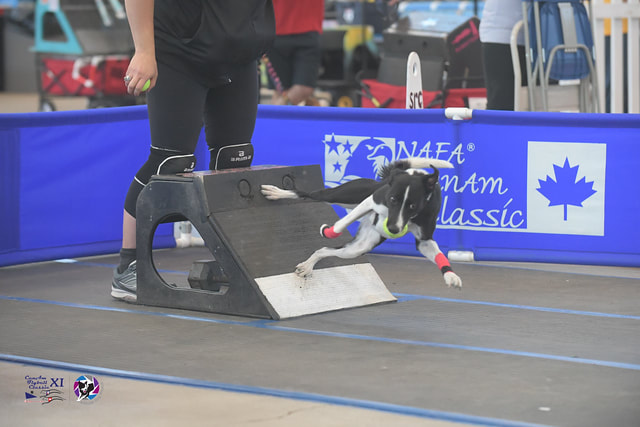|
I see a wide variety of sporting dogs and their handlers come through my clinic doors each year looking to improve their dog's physical capabilities. Each dog is unique and whether it is helping a dog recover from an injury or developing a preventive game plan to maximize their sport potential, it is SO rewarding to help each of them work towards their individual goals. But if there is one sport that is under-represented in my as well as my fellow canine physio colleagues clinics is the flyball dog. Flyball is an intense sport and this week we're going to take a deep dive into the physical demands that flyball asks of our dogs, the potential injuries we may see, and explore how conditioning can help improve performance and reduce the risk of injury in these amazing athletes. What is Flyball? Flyball 101: How to Compete in Flyball for Dogs, AKC. Flyball 101: How to Compete in Flyball for Dogs, AKC. Flyball is a high speed, high impact sport. Teams of four dogs race a 51-foot lane jumping over a series of hurdles to a flyball box. The jump height for each team is determined by the shortest dog – called the “height dog” - on the team. The height is calculated by subtracting 5 inches from the wither height of the smallest dog on the team. The maximum hurdle height is 14 inches and the minimum is 7 inches. The first hurdle is spaced 6 feet away from the start/finish line, then 10 feet between each jump, and 15 feet from the box. Each team will line up their dogs for a quick release as the previous dog in the heat passes the start/finish line. To cut down on the run time of the entire team dogs are taught to pass each other. Once the dog has cleared the four hurdles, they come to the flyball box which releases a ball upon impact. Dogs are trained to hit the box with their front limbs, grab the ball and turn, to race back up the lane. Typically, the dogs are trained to always turn in the same direction. The current NAFA Regular record is 14.433 seconds and is held by team Border Patrol - a truly impressive feat! To do this sport well, flyball dogs will need several physical attributes such as...
During a competition a dog could run 20-25 runs a day - meaning that endurance is also an important trait to have! Having these traits will not only reduce the dog's risk of injury doing flyball but will also improve their performance! Training for this sport shouldn't just be focused on the mechanics of a box turn but should also focus on building strength, body awareness, flexibility, and coordination. The Physical Challenges of FlyballTo do this sport effectively, flyball dogs are asked to accelerate quickly, stride through a series of jumps, decelerate and collect and impact to grab a ball, and then accelerate back to the handler, all while striding effortlessly over four hurdles! This is usually all done on rubber mats over a concert floor! I know my flyball friends are tired and sore after a day of competition and I can only image how their dogs must feel! From a physiological standpoint lets break down a dog’s heat performance.
Potential injuries that can occurWith physical activity, there is always the risk of injury, but I argue that the benefits of sport far outweigh the risk of injury. As competitors and trainer partners, however, there is lots we can do to help prevent injury! A study conducted by the College of Veterinary Medicine at the University of Florida which examined 375 flyball dogs found that 39% percent of the dogs in the study had at least one injury in their sporting career. Injuries to the limbs were the most common, with 30.8% affecting forelimbs, 25.6% affecting hind-limbs, with the paw or nail being the most reported area (19.2%). A key factor in preventing injury is knowing the potential injuries that can occur in our sport of choice. Here are a few examples of common injuries in the flyball dog:
Injuries can be hard to spot! Due to the high drive nature of flyball some dogs will work through an injury. If your dog is showing poor form in the lane it may be due to injury. Handlers may be inclined to have their dogs perform drills and re-train their dogs because of a poor box turn performance but haven’t stopped to wonder if the poor performance is due to an hard-to-spot injury like a pulled muscle or a mis-alignment of the pelvis. Perhaps our flyball dog is avoiding the hurdles not from lack of training but because they’re shying away from an activity that is causing them pain. Without sufficient rest and rehab, these types of injuries can be exacerbated from continued training and repetitive drills. Injuries can seriously sideline your dog and put your training and competition goals on hold. As a handler, I know, that having a dog sidelined due to injury is heartbreaking! I would much rather invest my time into injury prevention then rehabbing an injury. Not only is it easier but it also means my dog can continue to do what they love, pain free, and I have the piece of mind knowing that if an injury should occur my dog is in a better place to come back to sport. A great way to prevent injury is to implement a proper warm-up and cool down routine. For flyball dogs, a warm-up will help to minimize potential injury risk and ensure the dogs muscles can activate maximally and appropriately. Given the explosive nature and speed of this sport, warmed up muscles will help to contribute to a better overall performance. I recommend that handlers develop a warm-up strategy that focuses on the major joints and muscles that flyball uses and in all three planes of motion. For more information on the importance of the warm-up and cool down make sure to check out my e-book - you can find it here! Conditioning the Flyball DogConditioning work can greatly benefit the flyball dog so I often find it surprising that flyball competitors are the least likely client to walk through my clinic doors! Conditioning work is crucial for any dog that participates in sport but there are some specific reasons why flyball competitors should consider conditioning for their dog. Due to the high intensity nature of flyball and the numerous physical demands placed on the dogs who compete conditioning can help both with injury prevention, improve performance, and increase longevity in sport. I'm a huge advocate for the importance of conditioning the sporting dog but there are three points I'd like to highlight for the sport of flyball.
SourcesCarney, Miranda. "Flyball 101: How to Compete in Flyball for Dogs," American Kennel Club, 2019
Lyons, Bobbi. "Flyball Fitness," Pawsitive Performance , 2014. Marcellin-Little, Denis. "Fitness and Conditioning in Sporting Dogs," The Veterinary clinics of North America. Small animal practice. Marcellin-Little, Denis. "Rehabilitation and conditioning of sporting dogs" The Veterinary clinics of North America. Small animal practice, 2005 Montalbano, Christina, Lauri-Jo Gamble, Katherine Walden, Jennifer Rouse, Sabine Mann, Danny Sack, Lauren G Wakshlag, Justin W Shmalberg, and Joseph J Wakshlag. “Internet Survey of Participant Demographics and Risk Factors for Injury in Flyball Dogs.” Frontiers in veterinary science 6 (November 14, 2019). "Undetected sporting injuries can reduce a dog's performance". Purina Pro Club Sporting Group Update 4(2)2-, 2006
2 Comments
Kayleigh BUSH
11/22/2021 07:55:20 am
Interested in the flyball injury statistics but cant find the source below.
Reply
Leave a Reply. |
AuthorCarolyn McIntyre Archives
March 2024
Categories
All
|



 RSS Feed
RSS Feed